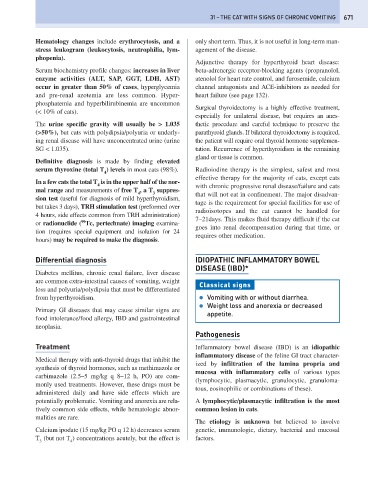Page 679 - Problem-Based Feline Medicine
P. 679
31 – THE CAT WITH SIGNS OF CHRONIC VOMITING 671
Hematology changes include erythrocytosis, and a only short term. Thus, it is not useful in long-term man-
stress leukogram (leukocytosis, neutrophilia, lym- agement of the disease.
phopenia).
Adjunctive therapy for hyperthyroid heart disease:
Serum biochemistry profile changes: increases in liver beta-adrenergic receptor-blocking agents (propranolol,
enzyme activities (ALT, SAP, GGT, LDH, AST) atenolol for heart rate control, and furosemide, calcium
occur in greater than 50% of cases, hyperglycemia channel antagonists and ACE-inhibitors as needed for
and pre-renal azotemia are less common. Hyper- heart failure (see page 132).
phosphatemia and hyperbilirubinemia are uncommon
Surgical thyroidectomy is a highly effective treatment,
(< 10% of cats).
especially for unilateral disease, but requires an anes-
The urine specific gravity will usually be > 1.035 thetic procedure and careful technique to preserve the
(>50%), but cats with polydipsia/polyuria or underly- parathyroid glands. If bilateral thyroidectomy is required,
ing renal disease will have unconcentrated urine (urine the patient will require oral thyroid hormone supplemen-
SG < 1.035). tation. Recurrence of hyperthyroidism in the remaining
gland or tissue is common.
Definitive diagnosis is made by finding elevated
serum thyroxine (total T ) levels in most cats (98%). Radioiodine therapy is the simplest, safest and most
4
effective therapy for the majority of cats, except cats
In a few cats the total T is in the upper half of the nor-
4 with chronic progressive renal disease/failure and cats
mal range and measurements of free T , a T suppres-
4 3 that will not eat in confinement. The major disadvan-
sion test (useful for diagnosis of mild hyperthyroidism,
tage is the requirement for special facilities for use of
but takes 3 days), TRH stimulation test (preformed over
radioisotopes and the cat cannot be handled for
4 hours, side effects common from TRH administration)
7–21days. This makes fluid therapy difficult if the cat
99
or radionuclide ( Tc, pertechnate) imaging examina-
goes into renal decompensation during that time, or
tion (requires special equipment and isolation for 24
requires other medication.
hours) may be required to make the diagnosis.
Differential diagnosis IDIOPATHIC INFLAMMATORY BOWEL
DISEASE (IBD)*
Diabetes mellitus, chronic renal failure, liver disease
are common extra-intestinal causes of vomiting, weight
Classical signs
loss and polyuria/polydipsia that must be differentiated
from hyperthyroidism. ● Vomiting with or without diarrhea.
● Weight loss and anorexia or decreased
Primary GI diseases that may cause similar signs are
appetite.
food intolerance/food allergy, IBD and gastrointestinal
neoplasia.
Pathogenesis
Treatment Inflammatory bowel disease (IBD) is an idiopathic
inflammatory disease of the feline GI tract character-
Medical therapy with anti-thyroid drugs that inhibit the
ized by infiltration of the lamina propria and
synthesis of thyroid hormones, such as methimazole or
mucosa with inflammatory cells of various types
carbimazole (2.5–5 mg/kg q 8–12 h, PO) are com-
(lymphocytic, plasmacytic, granulocytic, granuloma-
monly used treatments. However, these drugs must be
tous, eosinophilic or combinations of these).
administered daily and have side effects which are
potentially problematic. Vomiting and anorexia are rela- A lymphocytic/plasmacytic infiltration is the most
tively common side effects, while hematologic abnor- common lesion in cats.
malities are rare.
The etiology is unknown but believed to involve
Calcium ipodate (15 mg/kg PO q 12 h) decreases serum genetic, immunologic, dietary, bacterial and mucosal
T (but not T ) concentrations acutely, but the effect is factors.
3 4

